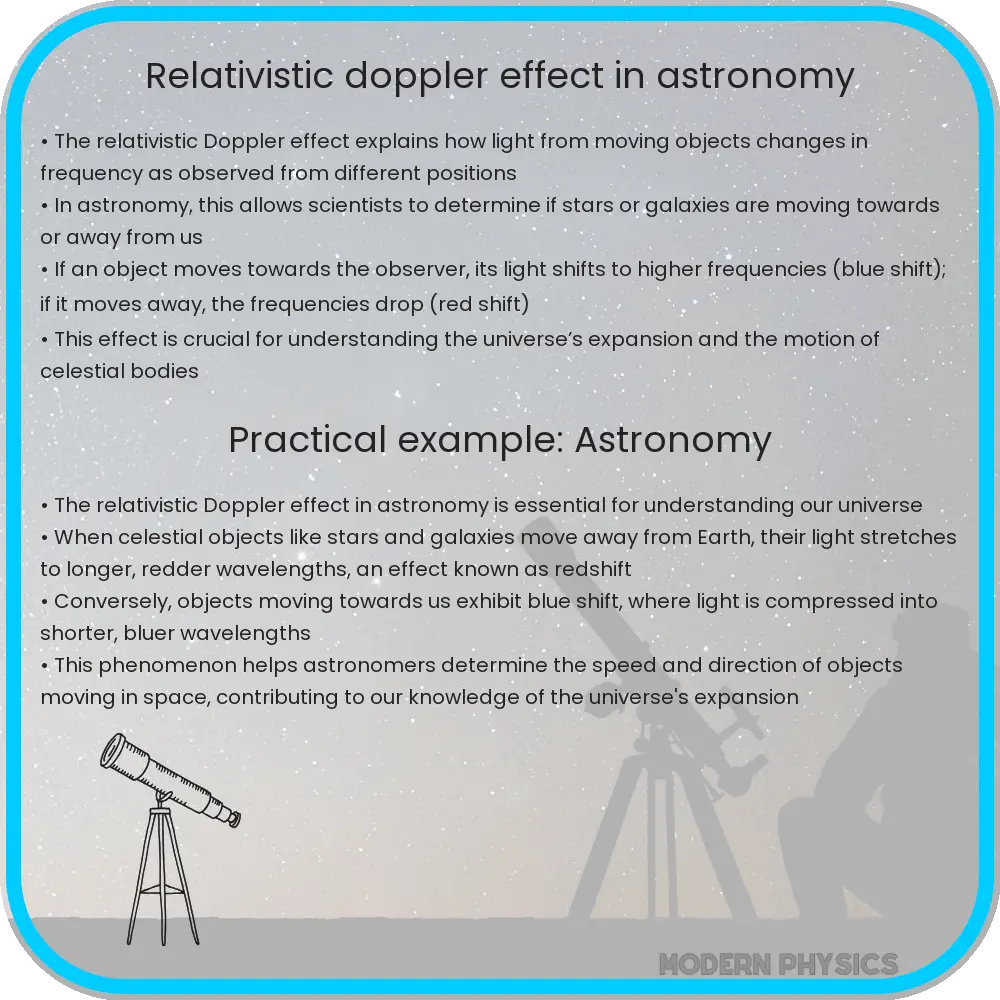Explore the Relativistic Doppler Effect: understand redshift, blueshift, and their critical role in modern astronomy and space exploration.

Understanding the Relativistic Doppler Effect
The Relativistic Doppler Effect is a fascinating phenomenon observed in the field of astrophysics, which provides insights into the motion and speed of objects in the universe. This effect is an extension of the classical Doppler Effect, taking into account the relativistic speeds close to the speed of light. It plays a crucial role in understanding cosmic phenomena and the behavior of distant celestial objects.
The Basics of the Relativistic Doppler Effect
At its core, the Relativistic Doppler Effect involves changes in the frequency or wavelength of light or other electromagnetic waves caused by the relative motion of the source and the observer. Unlike the classical Doppler Effect, which suffices for everyday phenomena involving sound waves or low-speed objects, the relativistic version becomes significant when dealing with objects moving at a substantial fraction of the speed of light.
Redshift and Blueshift
In the context of the Relativistic Doppler Effect, two key concepts are redshift and blueshift. Redshift occurs when an object is moving away from the observer, causing the observed wavelengths to stretch, making them appear longer and shifting towards the red end of the spectrum. Conversely, blueshift happens when an object is moving towards the observer, leading to a compression of the observed wavelengths, making them appear shorter and shifting towards the blue end of the spectrum.
Formula and Calculation
The mathematical representation of the Relativistic Doppler Effect is given by the formula:
\[ f’ = f \times \sqrt{\frac{1 + \beta}{1 – \beta}} \]
Where:
- f’ is the observed frequency.
- f is the actual frequency of the source.
- \(\beta\) is the speed of the source relative to the observer, expressed as a fraction of the speed of light.
This formula is derived from the principles of special relativity and takes into account time dilation and length contraction effects that occur at high velocities.
Observational Implications
The Relativistic Doppler Effect has profound implications in astronomy and cosmology. It helps astronomers determine the speed and direction of distant galaxies and stars. For instance, the redshift observed in the light from distant galaxies is a key evidence for the expanding universe theory. Similarly, blueshifts can indicate objects moving closer to Earth.
This effect is also crucial in studying binary star systems, pulsars, and black holes, where extremely high velocities are often involved.
Applications in Modern Astronomy
The Relativistic Doppler Effect is not just a theoretical concept but has practical applications in modern astronomy and space exploration. One of its most significant uses is in the field of exoplanet research. By analyzing the shifts in the spectral lines of a star, astronomers can deduce the presence of planets orbiting it. The periodic redshift and blueshift patterns indicate the gravitational influence of planets on the star.
Role in Gravitational Wave Detection
Another groundbreaking application is in the detection of gravitational waves. These ripples in spacetime, predicted by Einstein’s theory of relativity, were first observed in 2015. The Relativistic Doppler Effect plays a role in interpreting the signals received by detectors like LIGO and Virgo, as the movement of massive objects like black holes or neutron stars causes measurable shifts in the frequency of gravitational waves.
Challenges and Future Prospects
Despite its profound implications, the Relativistic Doppler Effect poses certain challenges. High precision measurements are required to detect tiny shifts in the spectrum of distant objects. The development of advanced telescopes and spectrometers is crucial for this purpose. Future prospects in this field are promising, with developments in technology and computational methods opening new doors to understanding our universe.
Conclusion
The Relativistic Doppler Effect is a cornerstone concept in astrophysics, offering a window into the dynamic processes of the cosmos. From aiding in the discovery of exoplanets to contributing to our understanding of the universe’s expansion, its applications are vast and varied. As we continue to explore the depths of space, the Relativistic Doppler Effect remains an essential tool for astronomers and physicists, enabling us to decipher the mysteries of the universe. The ongoing advancements in observational technology promise to further our knowledge, ensuring that the study of this phenomenon will continue to illuminate our understanding of the cosmos for years to come.
